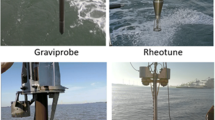Abstract
At the nautical bottom approach, part of the fluid mud layers can be included in the available depth if they present favorable rheology. As it is difficult to perform in situ rheological profiles, the most adopted procedure is to correlate these properties with other easier measurable ones, typically density. One technique for assessing in situ density profiles is the use of a tuning fork density probe. Density is calculated through frequency and amplitude signals, based in a specific algorithm from the employed device. This method requires a calibration, using local sediment at several densities, as it is conditioned by the rheology of the mud. In order to link the rheological properties of the fluid mud to the response of the tuning fork, first, an algorithm for density calculation was proposed and compared to the standard equipment software. Then, mud samples from different regions in Brazil were employed and a single curve associating the densitometer amplitude signal and the yield stress of the samples was obtained. The proposed approach enables a quick rheological assessment without laboratory rheological tests. It simplifies the steps of the protocol for establishing the critical limit once applying the nautical bottom concept, and it can be replied to other ports and navigation channels.






Similar content being viewed by others
References
Allwright D (2002) The vibrating tuning fork fluid density tool. Study Group Report, Smith Institute,London.
Barnes HA (2000) A handbook of elementary rheology. University of Wales - Institute of Non-Newtonian Fluid Mechanics, Aberystwyth
Benevides DCA, Dias FJS, Alfredini P, Gomes GH (2011) Mapping and estimative of fluid mud layers thickness at Itajai-Açu river port area , seeking improvements to navigation of deep-drafted vessels. In: 12th international congress of the Brazilian geophysical society. SBGf, Rio de Janeiro, Brazil, pp 1289–1294
Bruens AW (2003) Entrainment mud suspensions. Delft Univ. of Technology, Delft
Cabral AMR, Ramos F d S (2014) Cluster analysis of the competitiveness of container ports in Brazil. Transp Res A Policy Pract 69:423–431. https://doi.org/10.1016/j.tra.2014.09.005
Carneiro JC, Fonseca DL, Vinzon SB, Gallo MN (2017) Strategies for measuring fluid mud layers and their rheological properties in ports. J Waterw Port Coast Ocean Eng 143:04017008. https://doi.org/10.1061/(ASCE)WW.1943-5460.0000396
Claeys S, Staelens P, Vanlede J et al (2015) A rheological lab measurement protocol for cohesive sediment. In: INTERCOH2015: 13th International Conference on Cohesive Sediment Transport Processes. 7–11 September 2015. Leuven, Belgium
Fontein WF, Byrd RW (2007) The nautical depth approach, a review for implementation. In: WODCON XVIII ANNUAL DREDGING SEMINAR. WEDA
Granboulan J, Feral A, Villerot M, Jouanneau JM (1989) Study of the sedimentological and rheological properties of fluid mud in the fluvio-estuarine system of the Gironde estuary. Ocean Shorel Manag 12:23–46. https://doi.org/10.1016/0951-8312(89)90041-6
Groposo V, Mosquera RL, Pedocchi F, Vinzón SB, Gallo M (2014) Mud density prospection using a tuning fork. J Waterw Port Coast Ocean Eng 141:04014047. https://doi.org/10.1061/(ASCE)WW.1943-5460.0000289
Kineke GC, Sternberg RW, Trowbridge JH, Geyer WR (1996) Fluid-mud processes on the Amazon continental shelf. Cont Shelf Res 16:667–696. https://doi.org/10.1016/0278-4343(95)00050-X
McAnally WH, Friedrichs C, Hamilton D et al (2007a) Management of Fluid mud in estuaries, bays, and lakes. I: Present State of Understanding on Character and Behavior. J Hydraul Eng 133:9–22. https://doi.org/10.1061/(ASCE)0733-9429(2007)133:1(9)
McAnally WH, Teeter A, Schoellhamer D et al (2007b) Management of Fluid mud in estuaries, bays, and lakes. II: measurement, modeling, and management. J Hydraul Eng 133:9–22. https://doi.org/10.1061/(ASCE)0733-9429(2007)133:1(9)
McAnally WH, Kirby R, Hodge SH et al (2015) Nautical depth for U.S. navigable waterways: a review. J Waterw Port Coast Ocean Eng 142:04015014. https://doi.org/10.1061/(ASCE)WW.1943-5460.0000301
McBride M, Boll M, Briggs M et al (2014) Harbour approach channels - Design guidelines. PIANC Report No. 121. Bruxelles, Belgium
Mehta AJ, Samsami F, Khare YP, Sahin C (2014) Fluid mud properties in nautical depth estimation. J Waterw Port Coast Ocean Eng 140:210–222. https://doi.org/10.1061/(ASCE)WW.1943-5460.0000228
Pang Q, Zhang R (2015) Factors affecting the rheological characteristics of mud. In: INTERCOH2015: 13th international conference on cohesive sediment transport processes, 7–11 September. Leuven, Belgium
Papenmeier S, Schrottke K, Bartholomae A, Flemming BW (2013) Sedimentological and rheological properties of the water-solid bed Interface in the Weser and ems estuaries, North Sea, Germany: implications for fluid mud classification. J Coast Res 29:797–808. https://doi.org/10.2112/JCOASTRES-D-11-00144.1
Silva PD, Lisboa PV, Fernandes EH (2015) Changes on the fine sediment dynamics after the port of Rio Grande expansion. Adv Geosci 39:123–127. https://doi.org/10.5194/adgeo-39-123-2015
STEMA (2007) DensiTune® User’s Manual - Version 4.2. STEMA Survey Services. The Netherlands.
Teeter A (1992) The viscous characteristics of channel-bottom muds. U.S. Army Corps of EngineersWaterways Experiment Station. Dredging Research Program. Technical note DRP-2-04
Toorman EA (1994) An analytical solution for the velocity and shear rate distribution of non-ideal Bingham fluids in a concentric cylinder viscometer. Rheol Acta 33:193–202
Van Craenenbroeck K, Vantorre M, De Wolf P (1991) Navigation in muddy areas: establishing the navigable depth in the Port of Zeebrugge. In: CEDA-PIANC Conference (incorporating CEDA Dredging Days), 13–14 November: Accessible Harbours. Amsterdam
Wurpts RW, Torn P (2005) 15 years experience with fluid mud: definition of the nautical bottom with rheological parameters. Terra Aqua 22–32
Funding
The study receives financial support from the following Brazilian Research Agencies: CAPES (scholarship of second author, FAPERJ (scholarship of third author) and CNPQ (grant PQ 310297/2015-0 for the last author).
Author information
Authors and Affiliations
Corresponding author
Additional information
Responsible Editor: Francisco Pedocchi
This article is part of the Topical Collection on the 14th International Conference on Cohesive Sediment Transport in Montevideo, Uruguay 13–17 November 2017
Rights and permissions
About this article
Cite this article
Fonseca, D.L., Marroig, P.C., Carneiro, J.C. et al. Assessing rheological properties of fluid mud samples through tuning fork data. Ocean Dynamics 69, 51–57 (2019). https://doi.org/10.1007/s10236-018-1226-9
Received:
Accepted:
Published:
Issue Date:
DOI: https://doi.org/10.1007/s10236-018-1226-9




